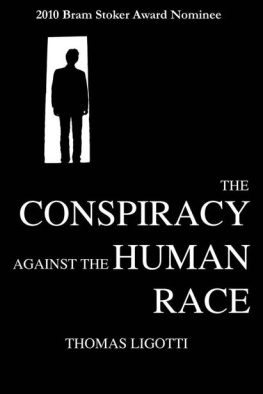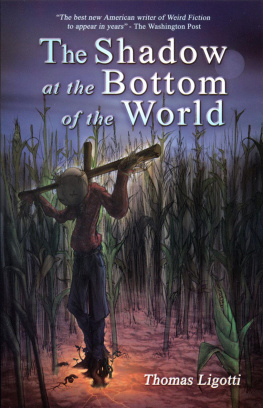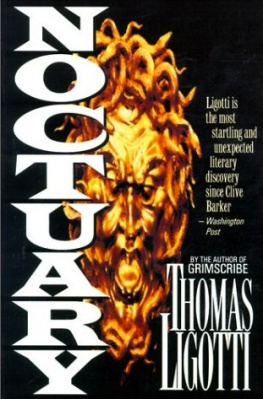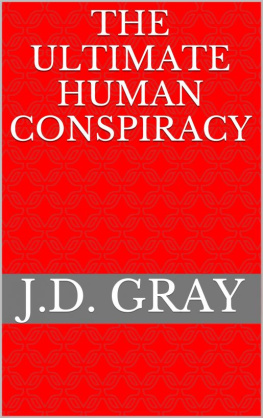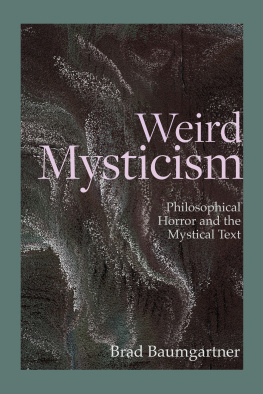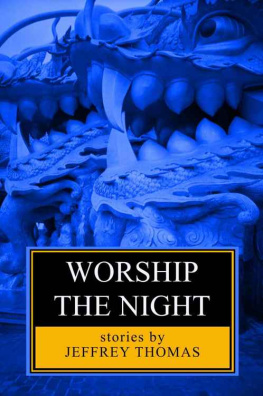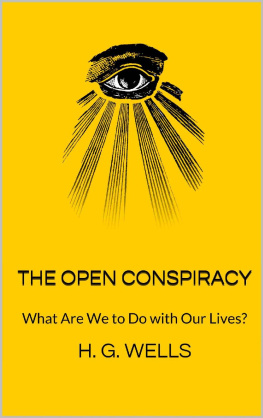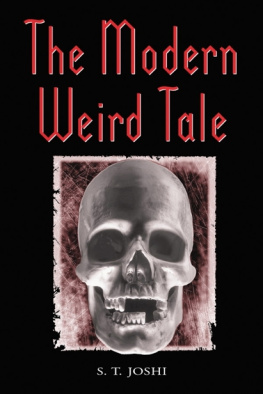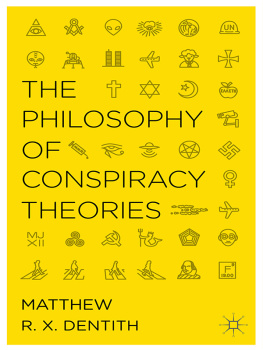THE CONSPIRACY AGAINST THE HUMAN RACE
Also by Thomas Ligotti
FICTION
Songs of a Dead Dreamer
Grimscribe
Noctuary
The Nightmare Factory
My Work Is Not Yet Done
The Shadow at the Bottom of the World
Teatro Grottesco
POETRY
I Have a Special Plan for This World
This Degenerate Little Town
Death Poems
SCREENPLAYS
Crampton (with Brandon Trenz)
The Frolic (with Brandon Trenz)
The Conspiracy against the Human Race
A Contrivance of Horror
Thomas Ligotti

Hippocampus Press
New York
Copyright 2010 Thomas Ligotti. Foreword 2010 by Ray Brassier. Thomas Ligotti photograph 2010 by Jennifer Gariepy.
Parts of this work were published, in different form, in the following publications: Literature Is Entertainment or It Is Nothing: An Interview with Thomas Ligotti by Neddal Ayad, Fantastic Metropolis (website), October 31, 2004; Thomas Ligotti on Sweeney Todd,Horror: Another 100 Best Books, Stephen Jones and Kim Newman, eds., 2005; Introduction by Thomas Ligotti, The Tenant by Roland Topor, 2006; Its All a Matter of Personal Pathology: An Interview with Thomas Ligotti by Matt Cardin, The Teeming Brain (weblog), 2006.
All excerpts from the works of Peter Wessel Zapffe Gisle R. Tangenes; used with permission. All excerpts from the writings of H. P. Lovecraft Robert C. Harrall; used with permission of Lovecraft Properties LLC.
Library of Congress Cataloging-in-Publication Data
Ligotti, Thomas.
The conspiracy against the human race: a contrivance of horror / Thomas Ligotti. 1st ed.
p. cm.
Includes bibliographical references.
ISBN 978-0-9824296-9-3 (hardcover) ISBN 978-0-9844802-7-2 (pbk.)
1. Horror in literature. 2. LiteraturePhilosophy. 3. Pessimism in literature. I. Title.
PN56.H6L55 2010
809.9164dc22
2010008781
Published by Hippocampus Press
P.O. Box 641, New York, NY 10156.
http://www.hippocampuspress.com
All rights reserved. No part of this work may be reproduced in any form or by any means without the written permission of the publisher.
Cover design by Jennifer Gariepy. Cover production by Barbara Briggs Silbert. Hippocampus Press logo designed by Anastasia Damianakos.
First Digital Edition(s) May 2012
1 3 5 7 9 8 6 4 2
ISBN 978-1-61498-030-8
Digital book(s) (epub and mobi) produced by Booknook.biz.
To the memory of Peter Wessel Zapffe
ACKNOWLEDGEMENTS
I would like to express my appreciation to Tim Jeski and Scott Wetherby for supplying me with materials essential to the writing of this work; to the members of Thomas Ligotti Online and its administrator, Brian Edward Poe, for participating in a forum of commentary on an early version of The Conspiracy against the Human Race; to Robert Ligotti for being a ready test subject whenever I needed an alert response from a mind akin to my own; and to Jennifer Gariepy for the encouragement and insight she has afforded me over many years. In addition, I would be more than remiss not to acknowledge the counsel and labors of S. T. Joshi, David E. Schultz, and Jonathan Padgett, with special recognition reserved for Nicole Ariana Seary, who granted me the benefit of her talents and experience during the most crucial stages of this books composition. Finally, I am indebted, as are all devotees of philosophical pessimism who are not knowledgeable of the Dano-Norwegian language, to Gisle R. Tangenes for his translations of and writings on the works of Peter Wessel Zapffe. The responsibility for the use made of these valued contributions lies entirely with the author.
CONTENTS
FOREWORD
Ray Brassier
We know what verdict is reserved for those foolhardy enough to dissent from the common conviction according to which being alive is all right, to borrow an insistent phrase from the volume at hand. Disputants of the normative buoyancy of our race can expect to be chastised for their ingratitude, upbraided for their cowardice, patronized for their shallowness. Where self-love provides the indubitable index of psychic health, its default can only ever be seen as a symptom of psychic debility. Philosophy, which once disdained opinion, becomes craven when the opinion in question is whether or not being alive is all right. Suitably ennobled by the epithet tragic, the approbation of life is immunized against the charge of complacency and those who denigrate it condemned as ingrates.
Optimism; pessimism: Thomas Ligotti takes the measure of these discredited words, stripping them of the patina of familiarity that has robbed them of their pertinence, and restoring to them some of their original substance. The optimist fixes the exchange rate between joy and woe, thereby determining the value of life. The pessimist, who refuses the principle of exchange and the injunction to keep investing in the future no matter how worthless lifes currency in the present, is stigmatized as an unreliable investor.
The Conspiracy against the Human Race sets out what is perhaps the most sustained challenge yet to the intellectual blackmail that would oblige us to be eternally grateful for a gift we never invited. Being alive is not all right: this simple not encapsulates the temerity of thinking better than any platitude about the tragic nobility of a life characterized by a surfeit of suffering, frustration, and self-deceit. There is no nature worth revering or rejoining; there is no self to be re-enthroned as captain of its own fate; there is no future worth working towards or hoping for. Life, in Ligottis outsized stamp of disapproval, is MALIGNANTLY USELESS.
No doubt, critics will try to indict Ligotti of bad faith by claiming that the writing of this book is itself driven by the imperatives of the life that he seeks to excoriate. But the charge is trumped-up, since Ligotti explicitly avows the impossibility for the living to successfully evade lifes grip. This admission leaves the cogency of his diagnosis intact, for as Ligotti knows full well, if living is lying, then even telling the truth about lifes lie will be a sublimated lie.
Such sublimation is as close to truth-telling as Ligottis exacting nihilism will allow. Unencumbered by the cringing deference towards social utility that straightjackets most professional philosophers, Ligottis unsparing dissection of the sophisms spun by lifes apologists proves him to be a more acute pathologist of the human condition than any sanctimonious philanthrope.
Look at your body
A painted puppet, a poor toy
Of jointed parts ready to collapse,
A diseased and suffering thing
With a head full of false imaginings.
The Dhammapada
INTRODUCTION:
OF PESSIMISM AND PARADOX
In his study The Nature of Evil (1931), Radoslav A. Tsanoff cites a terse reflection set down by the German philosopher Julius Bahnsen in 1847, when he was seventeen years old. Man is a self-conscious Nothing, wrote Bahnsen. Whether one considers these words to be juvenile or precocious, they belong to an ancient tradition of scorn for our species and its aspirations. All the same, the reigning sentiments on the human venture normally fall between qualified approval and loud-mouthed braggadocio. As a rule, anyone desirous of an audience, or even a place in society, might profit from the following motto: If you cant say something positive about humanity, then say something equivocal.
Returning to Bahnsen, he grew up to become a philosopher who not only had nothing either positive or equivocal to say about humanity, but who also arrived at a dour assessment of all existence. Like many who have tried their hand at metaphysics, Bahnsen declared that, appearances to the contrary, all reality is the expression of a unified, unchanging forcea cosmic movement that various philosophers have characterized in various ways. To Bahnsen, this force and its movement were monstrous in nature, resulting in a universe of indiscriminate butchery and mutual slaughter among its individuated parts. Additionally, the universe according to Bahnsen has never had a hint of design or direction. From the beginning, it was a play with no plot and no players that were anything more than portions of a master drive of purposeless self-mutilation. In Bahnsens philosophy, everything is engaged in a disordered fantasia of carnage. Everything tears away at everything else forever. Yet all this commotion in nothingness goes unnoticed by nearly everything involved in it. In the world of nature, as an instance, nothing knows of its embroilment in a festival of massacres. Only Bahnsens self-conscious Nothing can know what is going on and be shaken by the tremors of
Next page
